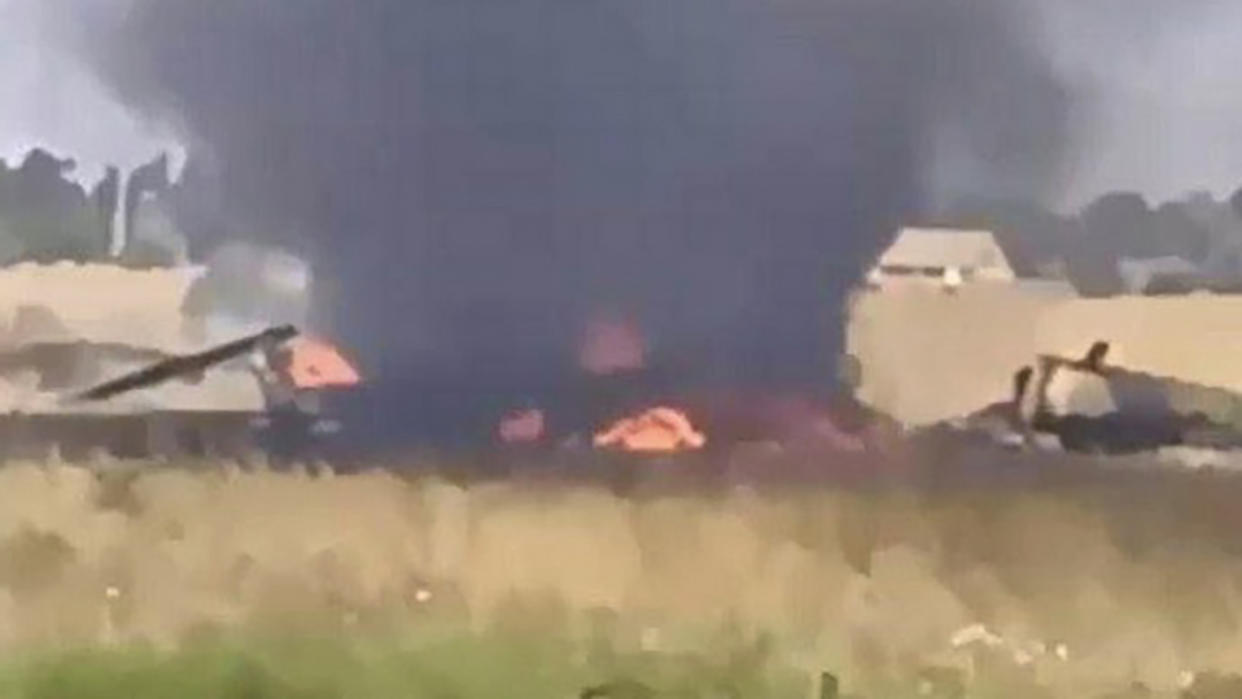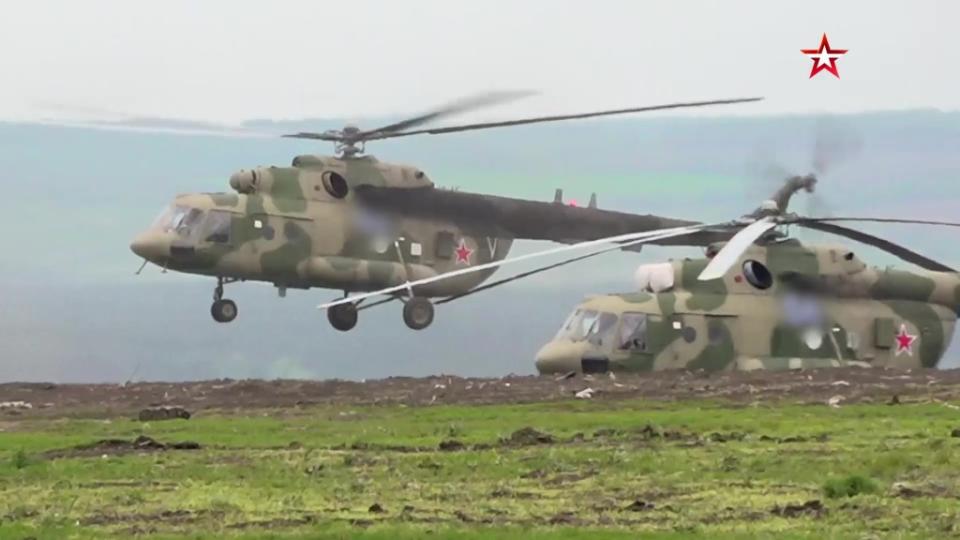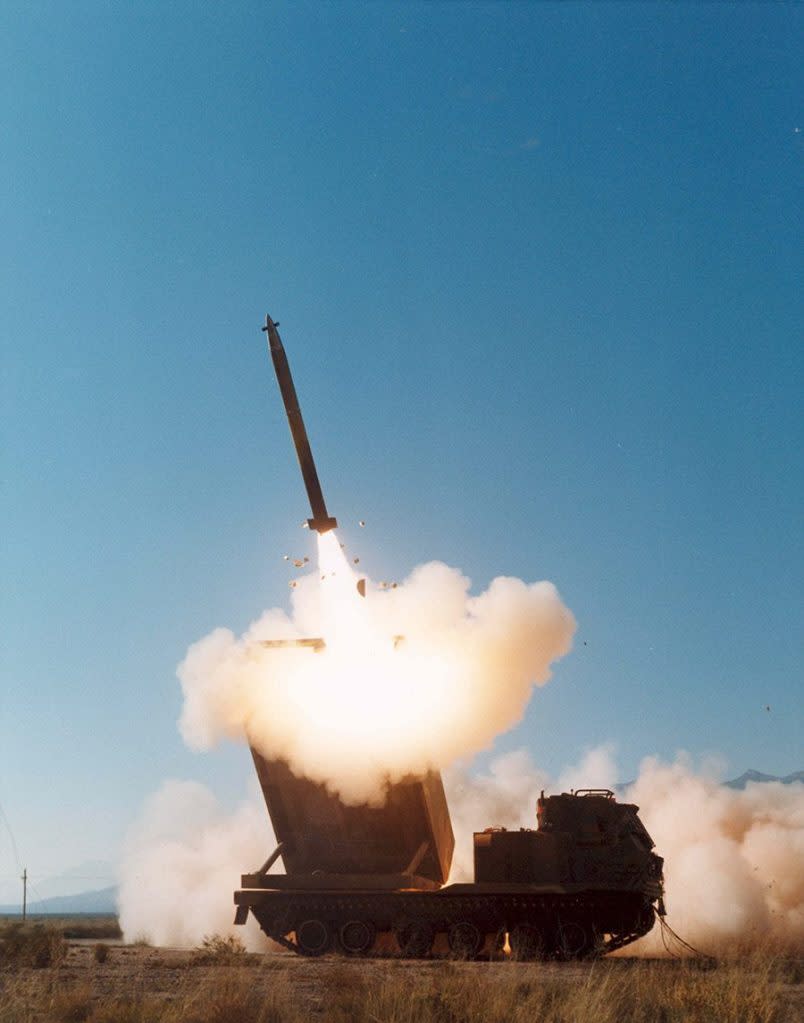Ukraine Situation Report: Russians Say Mi-8 Hip Helicopter Was Shot Down By Drone

This morning, a Russian Mi-8AMTSh Hip helicopter crashed near Donetsk City. Russian sources report it was downed by a Ukrainian one-way attack drone.
“Yesterday we wrote about the enemy’s attempts to operate drones against our army aviation,” wrote the Voivode Broadcasts Telegram channel, which first reported the incident. “Unfortunately… today they succeeded.”
The helicopter was hit “at the moment of takeoff,” Voivode Broadcasts wrote.
This morning, a Russian Mi-8 transport helicopter crashed near Donetsk City.
Russian sources report it was downed by a Ukrainian FPV drone.
Seen here, the wreckage burns in an open field. pic.twitter.com/IcFpizwbV1— OSINTtechnical (@Osinttechnical) July 31, 2024
AFU sources report the downing of a Russian Mi-8 helicopter in the #Donetsk area. They burn well…#OSINT #UkraineWar #BreakingNews #BreakingNow #Ukraine #Russia
Reposts appreciated! pic.twitter.com/hIzEknP0Tv— OSINT (Uri Kikaski)
(@UKikaski) July 31, 2024
/1. Russian sources associated with Russian military aviation report that a Russian Mi-8 helicopter crashed/was downed near Donetsk. No information regarding the crew yet. pic.twitter.com/onNuq0Pbrt
— Special Kherson Cat
(@bayraktar_1love) July 31, 2024
The War Zone cannot independently confirm this claim, however, several prominent Russian Telegram channels are saying it did indeed happen.
“Today we have a loss in the Donetsk region; the enemy shot down a Mi-8 military transport helicopter using a drone,” the Colonelcassad Telegram channel wrote. “There are dead and wounded.”
The Russian Aerospace Forces-connected Fighterbomber Telegram channel also confirmed the claims.
“This is true about the Mi-8. Unfortunately,” Fighterbomber stated.
“The enemy hit our Mi-8 near Donetsk,” Kremlin Snuff Box claimed on Telegram. “Sources confirm the information that on the territory of the [so-called Democratic People’s Republic] DPR, the enemy, using kamikaze drones, hit our Mi-8 helicopter. Unfortunately, the enemy is adapting and this is not very good news for us. There were wounded soldiers on board. However, army aviation continues its work.”
Another channel dismissed claims the helicopter was downed by friendly fire.
“And yes – they would ask you to keep the nonsense that the helicopter was shot down by our air defense,” it stated.

So far, neither Russian nor Ukrainian authorities have confirmed the loss or what caused it. Prominent Ukrainian journalist Yuriy Butusov said that if confirmed, this would be a historic event.
“The entire crew and passengers were liquidated,” he wrote on Telegram. “The cost of the Mi-8 itself is no less than $15 million. If it is confirmed about the drone, then this is a historical achievement worthy of the highest awards in Ukraine. Previously, the Ukrainians had repeatedly published videos of unsuccessful attempts to intercept helicopters on the front line, but for the first time an interception was announced where the enemy did not expect it, at a rear airfield.”
While a significant and perhaps somewhat historic development, there is no reason why a man-in-the-loop controlled drone cannot strike a helicopter, especially in the terminal stages of flight, when it is very low and slow. This is a notorious area of vulnerability for helicopters operating in combat zones and especially close to the front lines.
Some anti-tank guided missiles can also take out helicopters under certain circumstances. You can read all about this capability here. But those weapons cannot strike a dozen miles away, at least the traditional kinds that require line-of-sight to the target. Non-line-of-sight anti-tank guided missiles, including ones Russia has apparently received from North Korea, can do this farther away and in a far more dynamic manner.
Video of SyAAF Gazelle being shot down by a BGM-71 TOW pic.twitter.com/DKPYmREJjr
— BM-27 Uragan (@bm27_uragan) September 2, 2016
Ukraine is working to rapidly expand its drone-on-drone interceptor fleet, which could also be used against rotary-wing aircraft. Drones engaging in air-to-air combat began to emerge not long after the conflict erupted. FPV drones, especially ones operating in conjunction with an airborne relay system, can absolutely hit a slow-moving helicopter a dozen miles behind the front lines. As lower-end drone technology fuzes with AI/machine learning, these drones will be able to prosecute such targets of opportunity on their own, with the shackles of maintaining line-of-sight connectivity taken off. You can read more about this terrifying but fast-approaching reality here.
Ukrainian FPV drone attacks and destroys Russia’s ZALA ISR UAV. https://t.co/gY01Xk5CqB pic.twitter.com/S03USttHDl
— Samuel Bendett (@sambendett) June 12, 2024
The lack of helicopter losses due to lower-end drones is more of a result of rotary-wing aircraft operating in only a limited degree close to the front due to the layered air defense overlay that threatens them. In addition, the basing of Russian helicopters has been pushed far out and made less predictable due to the vulnerability of helicopters on the ground to standoff weaponry like HIMARS and ATACMS even when working out of bases dozens of miles behind enemy lines. There is also the risk of forces operating behind the front lines using FPVs to strike targets of opportunity, especially lumbering helicopters.
Before diving into more developments from the conflict in Ukraine, The War Zone readers can review our previous coverage here.
The Latest
On the battlefield, Russia continues to push toward the key Ukrainian logistics hub of Pokrovsk in Donetsk Oblast, according to the latest assessment from the Institute for the Study of War.
Kharkiv Oblast: Russian forces have likely seized the entire Vovchansk Aggregate Plant in Vovchansk (northeast of Kharkiv City) and continued ground attacks in northern Kharkiv Oblast.
Luhansk Oblast: Fighting continued along the Kupyansk-Svatove-Kreminna line, but there were no confirmed changes to the frontline.
Donetsk: Russian forces made significant tactical advances northwest of Avdiivka amid continued intensive efforts to advance and conduct a limited tactical encirclement of Ukrainian forces near Pokrovsk. The Russians also held positions northwest and southwest of Avdiivka and seized Vovche, about 14 miles east of Pokrovsk. They also continued intensive attacks on Tortetsk, advancing in some areas and recently advanced southwest of Donetsk City.
Donetsk-Zaporizhzhia border: Russian forces continued limited offensive operations in the Donetsk-Zaporizhia Oblast border area on July 29 but did not make any confirmed advances.
Zaporizhzhia Oblast: Positional engagements continued in western Zaporizhia Oblast on July 29, but there were no confirmed changes to the frontline.
Kherson Oblast: Positional engagements continued on the east (left) bank of the Dnipro River and on the islands in its delta.
NEW: Russian forces conducted five platoon- to battalion-sized mechanized assaults in western Donetsk Oblast on July 29 and 30. Such localized mechanized pushes are likely the manifestation of Russia's forecasted summer offensive – Russian forces likely lack the wider operational… pic.twitter.com/fDosTDO3bM
— Institute for the Study of War (@TheStudyofWar) July 31, 2024
The abundance of drones over the battlefield is creating a tremendous problem for the Russian Army’s logistics, a noted Russian military reporter complains.
“During the Great Patriotic War, soldiers were fed hot meals two times a day in the trenches,” wrote Alexander Kharchenko. “A modern soldier cannot dream of such privileges. There are food items in the warehouses, but it is impossible to deliver hot food to the front lines. The number of drones at the front is growing and our enemy is delivering the main blow to military logistics.”
Last year, Russian troops were able to deliver supplies a kilometer from the front lines near Robotyne in Zaporizhzhia Oblast, but no more thanks to Ukrainian drones.
“In just a year, enemy drones began to fly much further and more often, and the armor is unloaded 8 to 10 kms from the front lines,” Kharchenko explained. “The needs of the front line are enormous and transportation options are severely limited. They jump into quieter places using motorcycles and ATVs, and they drag everything only with their feet into the most inaccessible places.”
This has forced Russia to turn to drones to deliver supplies, but they are Mavics and first-person view drones too small to carry much more than a water bottle.
There are samples of “heavier drones” shown at exhibits, “but I have not seen them on the front lines. I have seen ground-based drones, but these are all prototypes that fall into the hands of the infantry, and they stop working after a couple of days of operation.”
The logistic problems will only get worse as the weather turns and foliage that provides cover dies off.
“In the summer, ‘green stuff’ forgives many logistics mistakes,” wrote Kharchenko. “In autumn and winter, problems will be quadrupled. I see a solution to the problem in the use of heavy drones and unmanned platforms. And this should be done by specially trained advanced logistics teams. There is no magic wand. Just hard, painstaking work that needs to start now.”
Russian military reporter Alexander Kharchenko reports that logistics on the Russian side are getting worse over time due to the abundance of drones on the Ukrainian side. He says that even a year ago in Robotyne they were dismounted 1 kilometer from the positions, but now… pic.twitter.com/mIlYTAOVno
— WarTranslated (Dmitri) (@wartranslated) July 27, 2024
The U.S. announced its latest tranche of military assistance to Ukraine. Among many other items, the $1.7 billion package includes munitions for National Advanced Surface-to-Air Missiles Systems (NASAMS), Guided Multiple Launch Rocket Systems (GMLRS)) rockets for the M142 High Mobility Artillery Rocket Systems (HIMARS) and the M270 Multiple Launch Rocket System (MLRS) provided to Ukraine, 155 mm and 105 mm artillery shells, FGM-148 Javelin and AT-4 anti-armor systems.
The aid comes from two sources. Up to $200 million is coming from Presidential Drawdown Authority (PDA) funding from existing stocks of air defense interceptors; munitions for rocket systems and artillery; and anti-tank weapons.
Another $1.5 billion worth of equipment comes from Ukraine Security Assistance Initiative (USAI) funds for items that have to be procured. That includes air defenses, fires, anti-tank weapons and funding to sustain equipment previously committed by the United States.
In addition to the previously mentioned items, these packages include:
Short- and medium-range air defense munitions;
RIM-7 missiles for air defense;
Electronic Warfare equipment;
120 mm mortar rounds;
Precision aerial munitions;
Tube-Launched, Optically-Tracked, Wire-Guided (TOW) missiles;
Small arms;
Explosives material and demolitions equipment and munitions;
Secure communications systems;
Commercial satellite imagery services; and
Spare parts, maintenance and sustainment support, and other ancillary equipment.
This is the Biden Administration’s 20th USAI package and 62nd PDA tranche of equipment to be provided from DoD inventories for Ukraine since August 2021.

Ukraine’s Defense Intelligence Directorate (GUR) announced that operations against Wagner Private Military Company (PMC) mercenaries in the African nation of Mali will continue.
GUR spokesman Andrii Yusov “confirmed that the successful military action against Wagner units in Mali was facilitated by crucial intelligence,” on national television, Ukraine’s official United24 news outlet stated. “The rebels received not only the necessary information but also actionable intelligence that enabled them to carry out a successful operation against Russian war criminals.”
The Ukrainian spy agency has been operating against Wagner in Africa for at least nearly a year, as we previously reported. Video from one such engagement emerged online, which you can see below.
It is claimed that the video shows the work of
Ukrainian special forces in Sudan against the "Wagner" PMC and local rebels from the "Rapid Reaction Forces".
These videos and information about the actions of Ukrainian intelligence in Sudan were allegedly confirmed by sources… pic.twitter.com/pdimdEv1na—
MilitaryNewsUA
(@front_ukrainian) October 6, 2023
On July 27, Tuareg rebels from the Permanent Strategic Framework for Peace, Security and Development (CSP-PSD) movement released images and footage showing the destruction of a Wagner convoy near Tinzaouatene, close to the Mali-Algeria border. The clashes, which occurred on July 25 and 26, resulted in the deaths of at least 20 Wagner members, with survivors being captured, United24 reported.
Wagner, in a rare statement, said its forces had fought alongside Mali soldiers from July 22-27 and that its fighters were commanded by Sergei Shevchenko, whose callsign was “Pond,” Reuters reported. “On the first day, the ‘Pond group’ destroyed most of the Islamists and put the rest to flight,” Wagner said on Telegram. “However, (an) ensuing sandstorm allowed the radicals to regroup and increase their numbers to 1,000 people.”
There were reportedly scores of Russians killed, including Nikita Fedyanin, administrator of the popular Grey Zone Telegram channel.
More footages and details of the incident in Mali, where the Russian Wagner unit has been destroyed, have appeared.
Among the killed Russians is Anton Yelizarov. This individual with callsign “Lotus” led the assaults again Soledar and Bakhmut in 2023. Along him it is now… pic.twitter.com/hIF4H7QWW1— (((Tendar))) (@Tendar) July 28, 2024
Wagner, as we have previously reported, has been active for years in Africa. It has assisted several post-coup governments as Russia seeks to expand its influence on the continent. Its presence on the continent grew after it was disbanded following former leader Yevgeny Prigozhin’s death in a plane crash just months after he led a failed putative putsch against Putin.
Along with Malian troops, Wagner wreaked havoc while in that nation.
Russian Wagner paramilitaries and Malian soldiers slaughtered over 500 people, raped women and tortured dozens of others during an attack on Moura village in Mali in 2022. Till this day, it’s still the biggest massacre in an African community involving Russian fighters. pic.twitter.com/8LsTScsO31
— Philip Obaji Jr. (@PhilipObaji) July 29, 2024
Open-source investigators should have an easier time identifying newly refurbished Russian T-72B3M tanks. That’s because they have distinctive rubber-fabric screens designed to protect the rear of the turret and the engine compartment, according to the Conflict Investigation Team (CIT).
“Recent footage obtained by the Conflict Intelligence Team shows a trainload of newly shipped T-72B3M tanks from the Uralvagonzavod plant with a new modification package, which we provisionally mark as Model 2024 (Obr. 2024),” CIT reported. “As is evident in the still images we have released, a new element has been added to the factory upgrade: rubber-fabric screens designed to protect the rear of the turret and the engine and transmission compartment. While additional modifications may also be present, they cannot be discerned from the available footage. Nevertheless, this distinctive feature—the rubber-fabric screens—will make it easy to identify tanks produced from the summer of 2024 onward.”
GUR carried out a cyberattack against the Russian central bank, a source in the agency told the Kyiv Independent.
The attack appears to be the latest in an ongoing cyber campaign, which began on July 23 and affected several top Russian banks, including Gazprombank, VTB, Raiffeisen Bank, and Alfa Bank, the publication reported.
The central bank’s services have become unavailable or began experiencing significant interruptions at around 11 a.m. local time, the source told the Kyiv Independent.
Ukraine's military intelligence agency (HUR) on July 29 carried out a cyberattack against the Russian central bank, a source in the agency told the Kyiv Independent.https://t.co/j8IKMPxEm1
— The Kyiv Independent (@KyivIndependent) July 29, 2024
UNS Chernihiv and UNS Cherkasy, two former Royal Navy Sandown class mine countermeasures vessels (MCMVs) provided to the Ukrainian Navy, recently left the British port of Portsmouth.
Though turned over to Ukraine, they are in the United Kingdom for crew training.
As of January when we last reported on the vessels, Ukraine had yet to ask Turkey to allow them to cross into the Black Sea. Under the 1936 Montreux Convention, Turkey can block the passage of military vessels through the Bosphorus and Dardanelles straits. The treaty does not apply to ships returning to home bases.
It is unclear if Ukraine has since requested such transit.
UNS Chernihiv outbound from sunny Portsmouth this morning followed by UNS Cherkasy.
Via @PortsmouthProudpic.twitter.com/Ulq1xxOopK— Navy Lookout (@NavyLookout) July 29, 2024
About 3,000 former inmates are now fighting for Ukraine under a law passed last month to boost Ukraine’s troop levels.
“They were given the option of trading jail time to fight on the frontlines,” Euro News reported. Those released under this program represent about 7% of Ukraine’s total prison population of about 42,000, the news outlet reported.
One of those new recruits, who goes by the callsign “Psycho,” said the new law has helped him.
“It’s good for us,” he told Euro News. “We can be useful, clear our name, start a new life. Help those who need us at the front.”.
Psycho was serving a six-year sentence for robbery, but that was dropped to less than a year after he opted to go to the front. He had been training for three days when Euro News interviewed him.
Every ex-convict in the program is treated in accordance with the Armed Forces’ charter and supervised by representatives of the Military Law Enforcement Service, the publication explained.
“At a training ground in Kharkiv Oblast, an instructor is teaching recruits how to handle grenades,” Euro News reported. “These future soldiers are part of the 57th Motorised Infantry Brigade – a group formed almost entirely of former prisoners. This model will be replicated across Ukraine in the weeks to come as the war rumbles on.”
Around 3,000 former prisoners were given the option to trade jail time for a role in the Ukrainian army. ‘Psycho’ – …six years for robbery but, in the end, served less than a year, deciding instead to go to the front. #War_in_Ukraine https://t.co/JTMpzm3Bzm
— #War_in_Ukraine #Facts #Opinions #Trends #Kharkiv (@HarZizn) July 29, 2024
The Security Service of Ukraine (SBU) and the National Police say they detained “six FSB henchmen in Odesa who set fire to military vehicles,” according to a post on SBU’s Telegram channel.
Those arrested were youths working for the Russian FSB, formerly the KGB.
“In two weeks, attackers tried to destroy more than 15 official SUVs,” the SBU said. “As a result of the special operation, all the members of the enemy cell were arrested almost simultaneously in different parts of the city.”
The suspects, aged 18 to 24, all worked as couriers for a popular food delivery service.
“They came to the attention of the FSB as active users of Telegram channels in search of easy earnings, where they left their ‘resumes,’” according to SBU.
The perpetrators, all in custody, face up to eight years in prison.

The latest battle between Ukrainian first-person view drones and Russian surveillance drones took place in the skies over the southern front. Last week, we showed you video of a Ukrainian FPV drone repeatedly ramming a Russian drone with a stick. This time, the video shows the FPV drone bumping into a Russian Supercam S350 drone, causing it to deploy its parachute and float to the ground.
In the skies over southern Ukraine, a Ukrainian FPV drone engages in an aerial jousting match with a Russian Supercam S350 UAV, successfully downing the Russian drone over Ukrainian-held territory. pic.twitter.com/OYEJpQIHAR
— OSINTtechnical (@Osinttechnical) July 31, 2024
Russian troops are learning how to use Kalashnikov MR-155 shotguns to defend against drones.
“The combat training is based on trapshooting with the use of shotguns,” the Russian Defense Ministry (MoD) said on Telegram. “Smoothbore guns of the 12-mm caliber are used for the training. Trainees fire shotgun cartridges at flying plate targets. Special attention is paid in training on countering unmanned aerial vehicles.”
Russian MoD video showing Russian soldiers training to counter FPVs with a Kalashnikov MR-155 shotgun.https://t.co/g46312V1Y3 https://t.co/bHK1aKBNx7 pic.twitter.com/ApKDjZwNiU
— Rob Lee (@RALee85) July 30, 2024
Drone operators in this war have shown some amazing ability to carry out precision strikes.
Ukrainian troops from the 80th Separate Airborne Assault Brigade flew an FPV drone through the open rear hatch of a Russian armored vehicle, setting it aflame.
Ukrainian soldiers from the 80th Separate Airborne Assault Brigade destroy a
Russian BMP pic.twitter.com/Hdh6fh3JcZ
—
MilitaryNewsUA
(@front_ukrainian) July 25, 2024
Meanwhile, Russian drone operators showed tremendous skill dropping a munition down the chimney of a Ukrainian-held building.
Video of a Russian UAV dropping a munition down a chimney. https://t.co/u9HjlGmvND pic.twitter.com/YtZA3p1ZE6
— Rob Lee (@RALee85) July 31, 2024
Speaking of drone-dropped munitions, Ukrainian troops fashioned a huge one out of two TM-62 anti-tank mines. It was carried by one of Ukraine’s large Baba Yaga drones. A video within the video purports to show it dropping on a target, creating a ball of flame, plumes of smoke and debris flying through the air.
By far the largest drone dropped device I've seen so far. That's 2x TM-62 AT mines strapped together and dropped on an enemy held position by a 'baba yaga' type drone. pic.twitter.com/jpVBfmglkZ
— Seveer of the 95th rifles (@Seveerity) July 30, 2024
In addition to ferrying troops, one of the missions of Russian so-called “turtle tanks” has been to clear minefields. That proved to be a mission impossible for the crew of the turtle tank seen in the video below. After clearing one mine, it struck another and erupted into a ball of flames.
Russian turtle tank with a mine trawl neutralises a mine, then mine neutralizes a turtle tank. pic.twitter.com/jRaWmI0lTO
— Special Kherson Cat
(@bayraktar_1love) July 30, 2024
Another Russian turtle tank fell victim to Ukrainian first-person view drones.
Donetsk Oblast, a pair of Ukrainian FPV munitions fly into a Russian turtle tank, penetrating its armor and causing a catastrophic ammunition detonation. pic.twitter.com/gzwqifrF5S
— OSINTtechnical (@Osinttechnical) July 30, 2024
The Ukrainian Deep State group released video showing an attack on Russian troops holed up in the Vovchansk Aggregate Plant in Donetsk Oblast.
Бійці РУБпАК "Khorne Group" 116 ОМБр поділилися з нами кадрами своєї роботи знищення кацапів на Вовчанському агрегатному заводі
200 кілограм пластиду та водню – і рецепт запуску московитів в космос готовий!
Тож насолоджуйтесь кадрами креативності та великого БУМу".
— DeepState UA (@Deepstate_UA) July 28, 2024
A Ukrainian sniper drone dropped a munition on a Russian boat. According to the Ukrainian Gora unit’s Telegram channel, three Russians were killed.
“The Russians did not swim ten meters to the berth,” the group stated. “A sniper hit a moving boat, and even in windy weather – and the three occupants are sent to feed the crayfish.”
Ukrainian sniper drone drop
— Kvist.P
(@kvistp) July 29, 2024
You can get a good sense of urban warfare in this video below showing Ukrainian troops clearing buildings in the destroyed town of Pivnichne, Donetsk Oblast.
Ukrainian soldiers carry out a sweep in a residential building in the settlement of Pivnichne, Toretsky direction pic.twitter.com/G5Ythg6ZvB
—
MilitaryNewsUA
(@front_ukrainian) July 30, 2024
And finally, things change quickly in war.
The 47th Separate Mechanized Brigade posted a video on Telegram of one of its U.S.-donated Bradley Fighting Vehicles driving down a road before encountering and surviving an attack. The Bradley crew unleashed more than two dozen rounds from the vehicle’s Bushmaster M242 25 mm automatic cannon.
“Every minute the atmosphere changes from picturesque landscapes with whole houses to broken roads, destroyed villages and burned cars,” the brigade wrote on Telegram. “All this changes literally before your eyes.”
Video of a Bradley from Ukraine’s 47th Mechanized Brigade coming under fire and surviving a strike. https://t.co/komsi8UL3y pic.twitter.com/HRehpSVp4S
— Rob Lee (@RALee85) July 30, 2024
Contact the author: howard@thewarzone.com


















